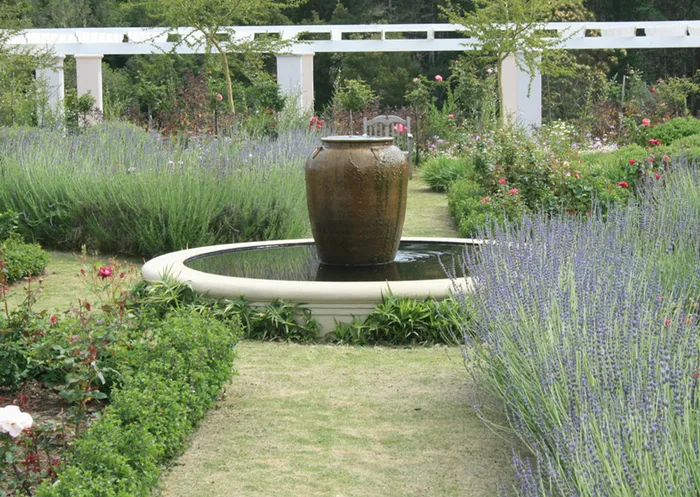The quintessential romantic garden

Lilac romance: Lavender evokes misty watercolour memories of love affairs long past. Lilac romance: Lavender evokes misty watercolour memories of love affairs long past.
A romantic garden is the ultimate retreat from the world. It is a place of private thoughts, relaxation and tranquillity.
By popular definition, a romantic garden contains roses (the symbol of love), lavender (the symbol of devotion), secret garden passages for those romantic liaisons, benches to share time with that special someone and the sounds of water to block out unwanted distractions.
l Romantic gardens
Each period in gardening history has defined romance in its own way and romantic gardens have changed through the centuries.
Persians created walled gardens filled with scented white flowering plants to distract lovers from the heat.
The Chinese and Japanese created romance by imitating the romantic natural scenes, complete with water and cherry blossom.
For the Greeks, the rose was the flower of their goddess of love, Aphrodite, and they wore garlands of roses on festive occasions and adorned their bodies with rose-scented oils. Romans associated roses with Cupid, the son of Venus and imported red roses from the island of Rhodes for perfume, and to decorate their lavish banquets.
French painter Claude Monet’s garden was the epitome of a romantic garden. He broke away from the strong lines and geometry so favoured by the early French designers of Versailles and used his garden like a painter uses a colourful palette to plant up a wild colour beside tranquil water features filled with water lilies.
For English poets, the idealised English cottage garden was an untamed wilderness of beauty filled with roses, spring daffodils, wild flowers and perennials.
Hollywood defined the romance of Africa in movies such as Out of Africa. Included in their visions were spectacular vistas, swirling grasses, burnt sunsets, timber decks in secluded forests, crystal streams and biodiversity-rich wetlands with abundant birdlife.
l Suburban romance
How do we create a romantic atmosphere in your modern suburban gardens? “The basic principles of good design, which include choice of style, scale direction and repetition, are to be found in successful romantic gardens,” says landscaper Arthur Mennigke.
How do you transform your garden into a dreamy romantic place? “Create a sense of mystery,” he says. “Create outdoor rooms to isolate you from the world and make use of fragrant plants such as roses, lavender and jasmine.”
l Design ideas
Planning to start planting up your romantic garden this Valentine’s Day? Consider these ideas:
English romance
In Victorian times, secret gardens were the perfect rendezvous for lovers. Winding paths led through shrubbery and mazes to vine-covered arbours and discreetly placed seats.
More recently, romantic cottage gardens were characterised by a rambling jumble of roses and old-fashioned perennials that spilled over the edge of paths and borders.
To create a wild cottage feel, add medicinal and culinary herbs to your garden and leave plants to self-seed. Add cabbagy old-fashioned roses, hollyhocks, violets, stocks, violas, pansies, poppies and honeysuckle.
Italian romance
The uncluttered Tuscan romantic garden speaks of alfresco lunches under trees and sleepy afternoons on mowed lawns. To develop this theme, plant apples, pears, grapevines, olives, rosemary, lavender and indigenous salvia.
Arbours have a timeless attraction in the Italian garden. Originally they were leafy shelters of boughs and vines. Summer houses, gazebos, even a simple latticework trellis, offer a private space, a hideaway, protection from public gaze. Add a hammock or a swing seat for two, and you have a garden for romance.
African romance
Surround yourself with the romantic beauty of Africa. Surround a wooden deck with indigenous restios shaded by pink flowering plants as you watch the sunset. Start by planting the Cape chestnut tree (Calodendrum capense), scented wild jasmine (Schrebera alata) or even vygies or mesembryanthemums (Lampranthus spp and Drosanthemum spp).
Add perennials in pretty shades of pink such as pelargonium, diascia, gazania, arctotis and nemesia. Add the autumn-flowering March lily (Amaryllis belladonna), the delicate blooms of Cyrtanthus carneus, the tall spires of the watsonia (Watsonia marginata) and the striking blooms of the candelabra flower (Brunsvigia bosmaniasi). For a shrubbery of delicate pink blooms, plant up Plectranthus ecklonii “Erma”. - Weekend Argus